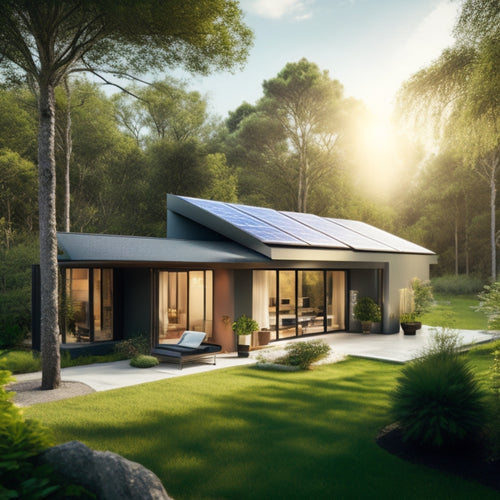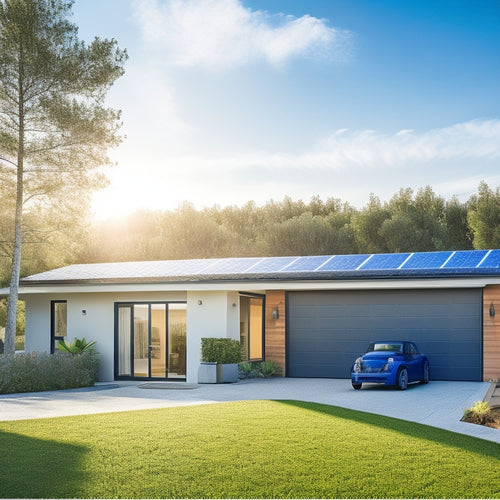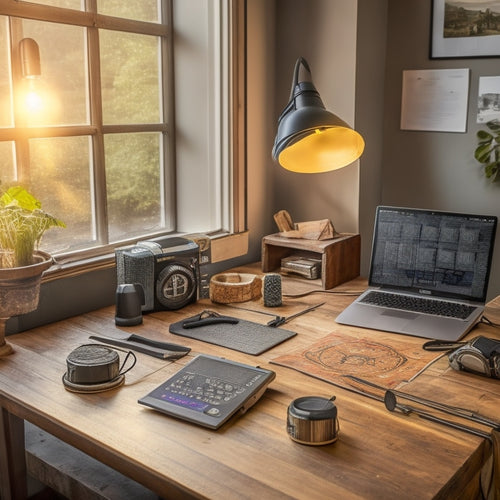
Setting Up Solar Power for Your House in 7 Easy Steps
Share
You're about to utilize the power of the sun and reduce your carbon footprint by setting up solar power for your house in 7 easy steps. Start by evaluating your energy needs, reviewing your past utility bills and researching local regulations and incentives. Next, choose the right equipment, including solar panels and inverters, and select a reputable installer with the necessary credentials and experience. Prepare your roof and home by conducting a thorough roof inspection and energy audit, then install the solar panel system, connect to the grid, and monitor its performance. Now that you've got the basics down, you're ready to explore deeper into the specifics that'll get you up and running with solar power.
Key Takeaways
- Assess your energy needs by reviewing past utility bills and researching local regulations and incentives to maximize your investment.
- Choose the right equipment, including solar panels, inverters, and battery storage, based on your energy needs and budget.
- Select a reputable installer with proper certifications, licensing, and insurance, and research their reputation and customer reviews.
- Prepare your roof and home by conducting a thorough inspection, evaluating energy efficiency, and implementing upgrades as needed.
- Regularly monitor and maintain your solar power system to ensure optimal performance, efficiency, and reliability.
Assess Your Energy Needs
As you commence on the expedition to employ solar power for your home, it's essential to determine how much energy you need to generate. To do this, you'll need to evaluate your energy consumption, which can be done by reviewing your past utility bills. This will give you an idea of your average daily energy usage.
Don't let solar myths deter you from making an informed decision; understanding your energy needs is fundamental to a successful installation.
Next, research local regulations and renewable incentives in your area, such as tax benefits, to maximize your investment. Consider the environmental impact of your energy consumption and how solar power can alleviate it.
You'll also want to investigate financing options and installation costs to guarantee a seamless shift to solar energy. Additionally, think about battery storage solutions to store excess energy generated during the day for use at night or during power outages.
Choose the Right Equipment
You'll need to determine your system requirements, including the size of the system and the number of panels, to guarantee you're generating enough power for your home.
Next, you'll need to choose the right type of solar panels, considering factors such as efficiency, durability, and cost.
System Requirements
Most homes require a solar power system with a capacity of 3-5 kilowatts to meet their energy needs.
When choosing the right equipment, you'll need to take into account the inverter type that suits your system. There are three main inverter types: string inverters, microinverters, and power optimizers. String inverters are the most common, but microinverters offer more flexibility and monitoring capabilities. Power optimizers are a hybrid of the two, offering a balance between cost and performance.
You'll also need to decide on battery storage. If you want to store excess energy generated during the day for use at night or during power outages, you'll need a battery storage system. The size of the battery bank will depend on your energy usage and the size of your solar array.
A typical residential battery storage system ranges from 5-15 kilowatt-hours. When selecting a battery, take into account factors such as depth of discharge, round-trip efficiency, and warranty.
Solar Panel Types
Having selected the right inverter and battery storage for your solar power system, it's time to focus on the heart of the system: the solar panels themselves. You'll need to choose from three primary types of solar panels: monocrystalline, polycrystalline, and thin film.
Monocrystalline panels offer the highest solar panel efficiency, but they're also the most expensive. Polycrystalline options are more affordable, with slightly lower efficiency. Thin film technology, while cheaper, has lower energy output and larger space requirements.
When selecting solar panels, consider installation costs, environmental impact, and aesthetic considerations. Look for panels with high-efficiency ratings, durable construction, and extensive warranty coverage.
Maintenance requirements should also be a factor, as some panels require more upkeep than others. Ultimately, the right solar panels for you'll depend on your specific needs, budget, and energy goals.
Select a Reputable Installer
By now, you've likely narrowed down your solar power system requirements and are ready to hand over the installation task to a professional. When selecting a reputable installer, it's essential to do your due diligence to guarantee a smooth and successful installation process.
Start by researching potential installers' credentials, such as certifications from organizations like the North American Board of Certified Energy Practitioners (NABCEP) or the International Association of Electrical Inspectors (IAEI). Check if they're licensed and insured, and verify their experience with installations similar to yours.
Next, read customer reviews from multiple sources, like Google, Yelp, or Angie's List, to get a sense of the installer's reputation and customer satisfaction. Pay attention to comments about their communication, work quality, and after-sales support.
Additionally, ask for references and contact them to inquire about their experience with the installer.
Prepare Your Roof and Home
You'll need to assess your roof's condition to guarantee it can support the added weight of solar panels and withstand the elements for years to come.
Additionally, consider making energy efficiency upgrades to your home to maximize the benefits of your new solar power system.
Roof Condition Assessment
As you prepare to employ the power of the sun, it's vital to evaluate the condition of your roof to confirm it can support the added weight and stress of solar panels.
A thorough roof inspection is essential to identify any potential issues that may affect the installation and performance of your solar power system.
During the inspection, you'll want to assess the age, material, and structural integrity of your roof.
Check for signs of wear, damage, or deterioration, such as curled or missing shingles, cracks, or loose flashing.
Weather considerations, like high winds, heavy snowfall, or intense sunlight, should also be taken into account.
Verify that your roof is strong enough to withstand these conditions and support the additional weight of the solar panels.
Additionally, inspect your roof's drainage system to confirm it can handle the added weight of snow and water.
A professional roofer or solar installer can help you conduct a thorough assessment and provide recommendations for any necessary repairs or upgrades before installing your solar power system.
Energy Efficiency Upgrades
Your roof has been deemed suitable for solar panels, but before installation, it's essential to prepare your roof and home for ideal energy efficiency. This requires an energy audit to identify areas of energy wastage and opportunities for improvement.
Insulation upgrades, for instance, can greatly reduce heat loss and gain, ensuring your home remains comfortable while minimizing energy consumption.
Replace traditional incandescent bulbs with LED ones and invest in energy-efficient appliances to reduce your overall energy load.
Consider upgrading to a smart home system that optimizes energy usage and provides real-time feedback on your consumption patterns.
By adopting sustainable practices, you'll not only reduce your carbon footprint but also benefit from renewable incentives and utility programs that offer rebates and discounts.
These upgrades will also increase the effectiveness of your soon-to-be-installed solar panels, allowing you to maximize your energy conservation efforts.
Install the Solar Panel System
How much of your roof will be dedicated to solar panels? This is an essential question to answer before installation begins. Your solar panel placement will depend on factors such as roof size, orientation, and obstructions like skylights or vents. A south-facing roof with minimal shading is ideal, but an experienced installer can work with your unique situation.
Once you've determined the best placement, it's time to obtain the necessary installation permits. These permits guarantee your system meets local building codes and safety standards. Your installer will handle the paperwork, but be prepared to provide documentation, such as your roofing plan and system design.
With permits in hand, the installation can begin. Your installer will carefully mount the solar panels, inverters, and other equipment to your roof.
They'll create a watertight seal and secure the system to withstand wind and weather. This is a vital step, as a well-installed system will generate maximum power and last for decades.
Connect to the Grid Successfully
Most homes with solar power systems are connected to the grid, allowing you to draw energy from the utility company when needed and sell excess energy back to the grid. This grid connection is essential for a seamless energy supply. To guarantee a successful connection, you'll need to:
| Step | Task | Responsible Party |
|---|---|---|
| 1 | Apply for utility agreements | You |
| 2 | Install a grid-tie inverter | Licensed electrician |
| 3 | Schedule a grid connection inspection | Utility company |
You'll need to apply for utility agreements, which outline the terms of your grid connection, including the rate at which you'll sell excess energy back to the grid. A licensed electrician will then install a grid-tie inverter, which synchronizes your solar power system with the grid's frequency and voltage. Finally, the utility company will schedule an inspection to ascertain your system meets safety and technical standards. Once you've completed these steps, you'll be ready to connect to the grid and start generating clean, renewable energy.
Monitor and Maintain Performance
The solar power system's performance relies heavily on regular monitoring and maintenance to confirm peak energy production and longevity.
You'll need to track performance metrics, such as energy output and efficiency, to identify areas for improvement. Create a maintenance schedule to guarantee regular checks on the system, including the inverter performance, wiring, and panel cleanliness. This will help you detect potential issues before they escalate.
Develop troubleshooting techniques to quickly identify and resolve problems, minimizing downtime and energy losses. Energy monitoring systems can provide real-time data on your system's performance, helping you optimize energy production.
Consider system upgrades to improve efficiency and adapt to changing weather patterns. Keep an eye on weather impacts, such as shading or extreme temperatures, which can affect your system's performance.
Frequently Asked Questions
Can I Install Solar Panels on a Rented Property?
You're considering solar panel options for your rented property, but you'll need to weigh renting considerations, like obtaining landlord approval and temporary installation methods, to guarantee a hassle-free experience.
Do Solar Panels Work During Power Outages?
You're wondering if solar panels work during power outages; unfortunately, they typically don't, as they're designed to feed excess energy back into the grid, but investing in a battery backup system can guarantee solar power reliability and home energy independence.
Are Solar Panels Affected by Bird Droppings?
Ah, you're worried about bird droppings ruining your solar panel game? Don't be ridiculous, you're not running a bird sanctuary up there! But seriously, bird droppings can impact your panel's efficiency, so regular cleaning is essential for ideal solar panel maintenance.
Can I Add More Panels to My Existing System?
You can expand your existing system, but make certain the new panels are compatible with your current setup. Assess your system's expansion options, considering factors like inverter capacity and wiring, to guarantee a seamless integration of additional solar panels.
Will Solar Panels Increase My Property Taxes?
You're wondering if solar panels will increase your property taxes; the answer depends on your location, as some states exempt solar panel valuation from property tax implications, while others may reassess your property's value, potentially leading to higher taxes.
Conclusion
You've done it! You've utilized the power of the sun and converted your humble abode into a sustainable energy powerhouse! With your brand-new solar panel system, you'll be saving the planet (okay, maybe not single-handedly, but every little bit counts!) and saving those hard-earned dollars on your energy bills. Now, sit back, relax, and bask in the glory of your eco-friendly genius – you've earned it!
Related Posts
-

Top-Rated Solar Storage Solutions for Homeowners
When considering top-rated solar storage solutions, you're looking at systems that provide energy independence and si...
-

Solar Energy Storage Options for Homes
When considering solar energy storage options for your home, you'll find several effective solutions. Battery systems...
-

Solar Inverter Troubleshooting for Beginners
Troubleshooting your solar inverter starts with understanding its efficiency and performance metrics. Check for prope...


